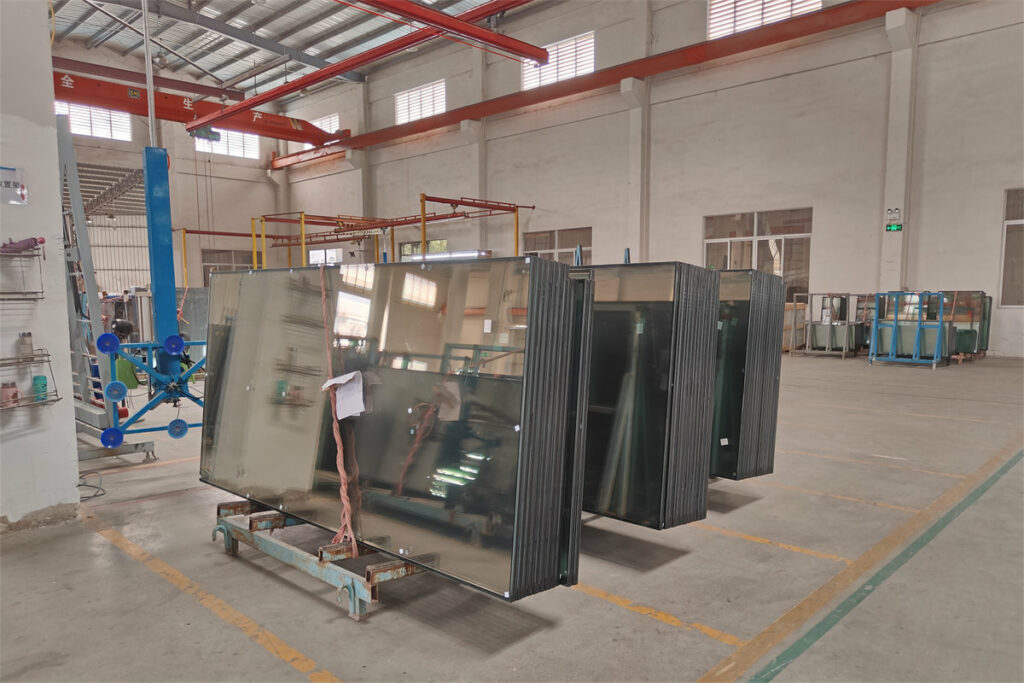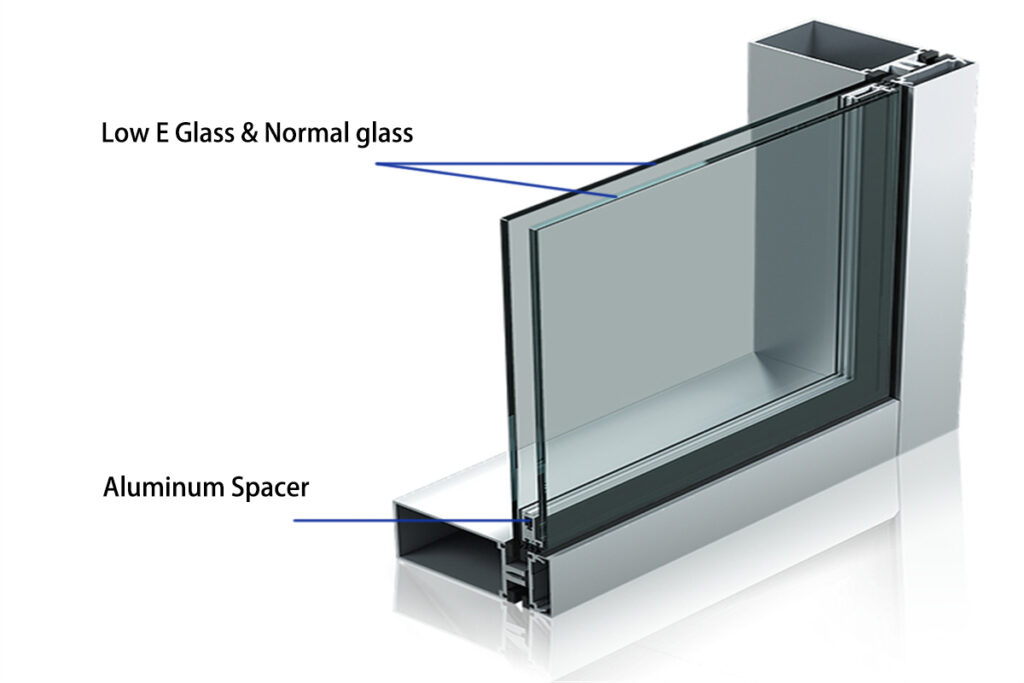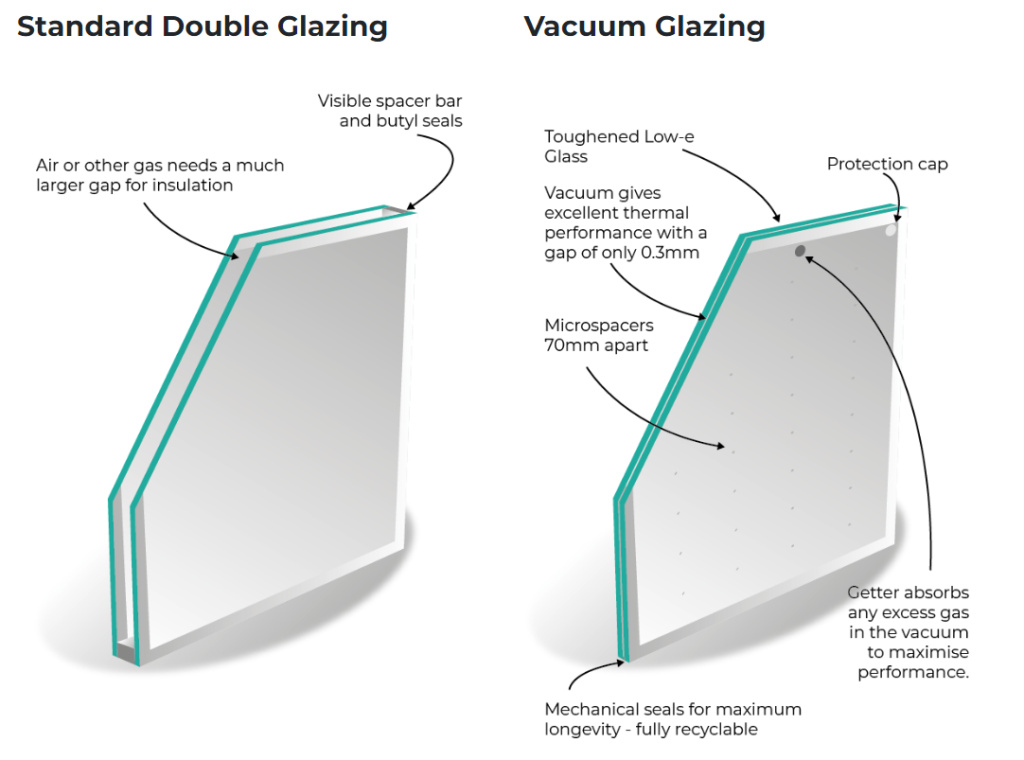What is the difference between insulated glass and vacuum glass? Many customers who purchase doors, windows, and curtain walls will be surprised when they hear this question, ‘What! Aren’t they the same product?’ Today, Dragon Glass will thoroughly popularize it for our clients and friends!
First, we need to know what is insulate double glazing?
Insulate double glazing, also known as double glazing, or insulated glass panel, is a type of window or glazing construction designed to reduce heat transfer and increase energy efficiency. It consists of two or more panes of glass separated by a space filled with an insulating material, often air or a gas like argon or krypton.
The space between the glass panes is sealed to prevent the ingress of moisture and to maintain the insulating properties. Some insulated glass units also have a desiccant material in the spacer, which absorbs any moisture that might have been in the air within the unit during manufacturing.
The insulated glass panel is commonly used in exterior windows, doors, and curtain walls because it significantly reduces the amount of heat that enters or exits a building, thus lowering heating and cooling costs. It also helps in reducing noise pollution, making it ideal for buildings in busy or noisy areas.


Specification of insulated glass
| Product Name | Insulated glass unit, double glazing unit |
| Thickness of Glass | 3+3mm, 4+4mm, 5+5mm, 6+6mm, 8+8mm, 10+10mm, 12+12mm, 15+15mm, 19+19mm |
| Thickness of Spacer | 6A, 9A, 12A, 15A, 16A, 19A, 21A |
| Color of Spacer | Natural, silver, black, grey, brown |
| Glass Type | Float glass, clear glass, low iron glass, tinted glass, reflective glass, low e glass, frosted glass, fluted glass, mirror |
| Dimension of Glass | Maximum: 3300x13000mm, minimum: 300x300mm |
| U value | 1.0-1.8 W/m2·K |
| Customized | Size, thickness, shape, edge, hole, logo |
| Lead Time | 15 days for normal type, others shall be negotiated. |
And what is vacuum glass?
Vacuum glass is made by sealing two flat pieces of glass around the edges, leaving a gap in between, which is then drawn into a vacuum and the exhaust port is sealed. One or two layers of transparent low-emission film are coated on the inner surface of the two pieces of glass. Vacuum glass is made by drawing a “vacuum” between two pieces of glass, essentially rendering it gas-free, and truly empty.
In 1993, the world’s first 1 meter by 1 meter vacuum glass sample was introduced. The inventors were Tang Jianzheng of the Physics Department of Peking University and R.E. Collins.
Vacuum glass supplier refers to drawing a vacuum between two pieces of glass. The vacuum layer is relatively thin. In order to achieve a balance of pressure inside and outside the glass, the glasses must be neatly arranged, adding flexible or rigid supports to withstand the pressure of the external atmospheric pressure. Vacuum glass is a custom product, and due to the atmospheric pressure, the requirements are relatively high. In principle, vacuum glass can be likened to a flat thermal flask.


Product Advantages
- Low carbon and energy-saving– relies on the special structure of the vacuum layer to effectively block the heat transfer between the interior and exterior. The heat transfer coefficient U value is below 0.6Wm-2k-1, which can be as low as 0.3W/(m·K), similar to that of the wall. It can significantly reduce air conditioning power consumption and the emission of pollutants and greenhouse gases, reducing environmental pollution.
- Heat insulation– by choosing a suitable shading coefficient for the vacuum glazed glass, it can effectively control solar heat gain in the summer, keeping the interior cool; in the winter, when the outdoor temperature is -20℃, the internal surface temperature of the vacuum glass is only 3-5℃ lower than the indoor air temperature, keeping the interior warm and comfortable.
- Sound insulation and noise reduction– with the increasing density of urban populations and the increase in transport vehicles, noise pollution is becoming more serious, directly harming people. The vacuum layer of vacuum glass can effectively block the transmission of sound, especially for medium and low frequencies with strong penetration, the effect is very significant.
- Avoid condensation– vacuum glazing has superior heat insulation performance. In cold winter, even if the outdoor temperature drops to -30℃, the temperature of the indoor glass surface is close to room temperature, far above the dew point.
- Wide range of applications– the interior of the vacuum glass is in a vacuum state, unaffected by atmospheric pressure, suitable for all altitudes; at the same time, the application of vacuum glass in all positions of a building can maintain its excellent performance, including facades, slopes, and roofs. There is no issue of gas convection increasing when insulating glass is laid flat leading to reduced performance.
Specification of vacuum glazing
| Product Name | Vacuum glazing, vacuum insulating glazed glass |
| Thickness of Glass | 4-6mm |
| Thickness of Spacer | 0.15V |
| Glass Type | clear glass, low iron glass, tinted glass, reflective glass, low e glass, frosted glass |
| Dimension of Glass | Maximum 3000x2000mm; minimum 200x200mm |
| U value | 0.4-2.2 W/m2·K |
| Customized | Size, thickness, shape, logo |
| Lead Time | 20-30 days |

The difference between IGU glass and vacuum insulating glass
Difference A
- The thickness of vacuum glass is much thinner than that of insulating glass, which can save installation space and frame material. At the same time, due to its good insulation performance, its anti-condensation and anti-fog performance is also better, avoiding the annoyance of not being able to see the outside view due to condensation on the window, as well as the soaking of the windowsill with dew.
Difference B
- The wind pressure resistance of vacuum glass is about twice that of insulating glass made of the same glass, but its impact resistance is not as good as insulating glass. This weakness can be solved by using composite vacuum glass. For example, in required positions, tempered glass can be added to one or both sides of the vacuum glass using laminated glass technology, making it a safe vacuum glass with high impact resistance and wind pressure resistance. However, the cost will undoubtedly increase accordingly.
Difference C
- As for the price, the price of ordinary insulating glass is not high, but the quality is uneven. Industry insiders know that the production process of vacuum glass is more complicated than that of insulating glass, the raw materials are more expensive, and the current production scale is smaller, so the price of vacuum glass is more expensive than that of insulating glass. Vacuum glass has double-layered, three-layered, or four-layered glass compositions, each of which is different, and the general price will be very high.

In any case, compared with other glass materials, these two types of glass are relatively expensive, and you can choose the appropriate amount according to the needs of decoration. In-home decoration, insulating, and vacuum glass can be used on balconies, doors, and windows to provide better heat insulation, sound insulation, and warmth preservation.
